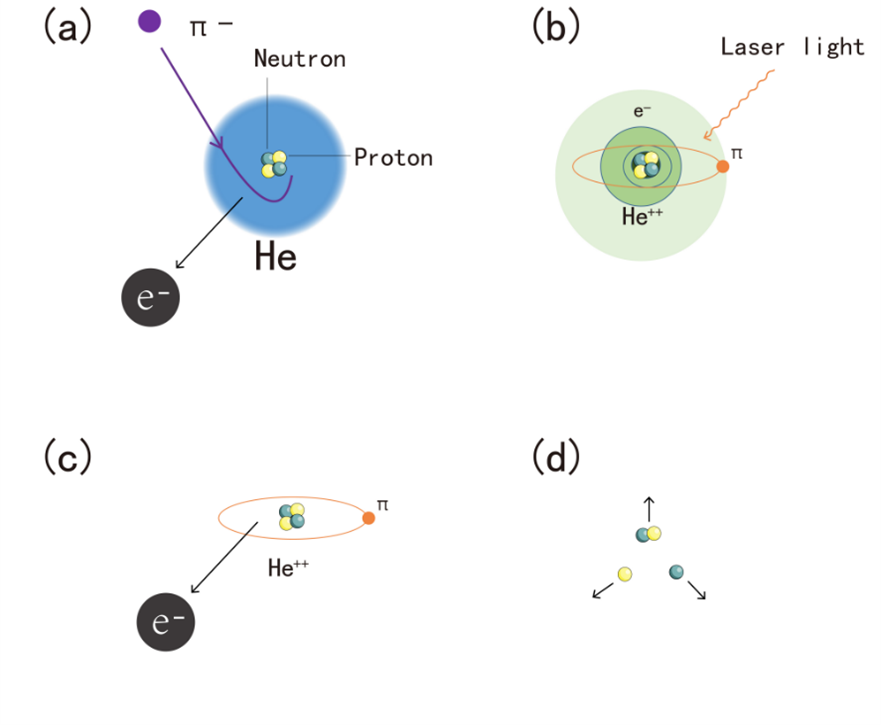Researchers at the Innovation Academy for Precision Measurement Science and Technology (APM) of the Chinese Academy of Sciences (CAS) have recently accomplished calculation of exotic atom π 4He+ (17,16)→(16,15) transition frequency. This result has reached an accuracy of 4 parts per billion (ppb) and is the most precise all over the world currently.
This work will improve the precision of pion mass by 2-3 orders in magnitude by combining the ongoing precision measurement at the Paul Scherrer Institute (PSI) of Switzerland. And the accuracy of neutrino mass will be improved by 2 orders in magnitude using the π+ decay experiment, which will provide significant information for the neutrino mass puzzle.
Relevant results were published on Physical Review Letters.
The existence of pion was firstly predicted by Japanese physicist Yukawa Hideki (Nobel Prize in Physics 1949) in 1935, and confirmed by British physicist Cecil Frank Powell in 1957. Pion is any of three subatomic particles π0, π- and π+. Pions are the lightest mesons (and, more generally, the lightest hadrons) with spin 0, which have masses of about 273 times of electron. They are unstable, with the charged pions π- and π+ decaying with a mean lifetime of 26 nanoseconds (2.6E-8 seconds), which causes the difficulty of precise pion mass measurement.
In the same year of pion detection in cosmic rays by Powell, American physicist Enrico Fermi predicted existence of exotic atoms by replacing electron with π-. These exotic atoms contain the π- in the discrete orbit providing opportunity to study its properties by laser technology. PSI has 1.3 MW proton ring cyclotron, and can provide high flux π- beam for pion helium spectroscopy measurement.
When the π- beam hits the helium gas, π- will take place one of two electrons in helium, trapped by metastable orbits. These orbits are far away from the nucleus, making the π- stay against nuclear capture in tens of nanoseconds, and make the laser spectroscopic experiment possible. Finally, the other electron is ejected, and π- decays to lower orbits, then captured by the nucleus, leading to nuclear fission resulting proton, neutron and deuteron.
Recently, more and more evidences indicate that the standard model of particle physics should be improved. In the pion decay, μ and W boson behave differ from the prediction of standard model (SM). In April 7th, 2021, Fermilab found that the anomaly magneton of μ deviates from the calculation of SM theory by 4.2 sigma. One year later, Fermilab announced that the W boson mass is measured to a value deviated from SM prediction by 7 sigma. These facts make the study of pion important.
Currently, the pion mass is measured by X-ray method to a level of 1E-6. It shows that pion helium spectroscopy has a potential to improve the pion mass to a better precision. The capture experiment of π- in helium can be track back to 60 years ago. Until recently, the existence of metastable pion helium was confirmed by PSI laser spectroscopic experiment. They detected the frequency of π4He+ (17,16)→(17,15) frequency.
It was a good start even this experimental precision cannot be used to improved pion mass. They are planning to measure the narrow (17,16)→(17,15) transition, potentially up to 1E-9 level. In order to achieve the goal of pion mass, it is necessary to theoretically calculate transition of (17,16)→(17,15).
The researchers of APM calculated the π4He+ (17,16)→(16,15) transition frequency, based on the complex coordinate rotation method based on gradient optimization (CCR-GO) method developed on their own, including leading order relativistic and radiative corrections (R∞α2 and R∞α3 orders), and R∞α4 and R∞α5 orders of corrections. Therefore, the theoretical prediction of this transition is improved to be 4 ppb (4E-9).
This work was supported by the National Natural Science Foundation of China, the Strategic Priority Research Program of CAS, and the CAS President's International Fellowship Initiative.

First Laser measurement for exotic atom pion helium. (Image by APM)
